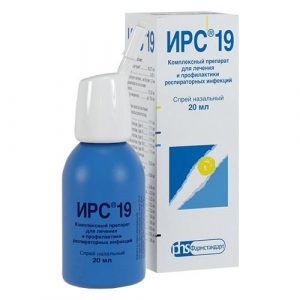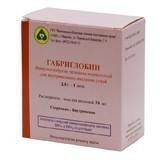Description
Latin name
REGEVAC B
Release form
Suspension for i / m administration of a white with a grayish tint, without visible foreign particles, separated after settling into a transparent supernatant and a white precipitate with a grayish tint, easily resuspended by shaking.
Pharmacological action of
Vaccine for the prevention of hepatitis B.
Indications
Prevention of hepatitis B:
– in children within the national calendar of vaccinations
– in people from the group who are infected with the virus and those who have the virus and the HIV virus or a patient with chronic hepatitis B children in orphanages, orphanages and boarding schools children and adults who regularly receive blood and its preparations, as well as those on hemodialysis and oncohematological patients)
– in people with roizoshel contact with the material infected with the hepatitis B virus
– health care workers who have contact with the blood of patients
– in individuals, employed in the production of immunobiological preparations from
donated and placental blood – from students of medical institutes and students of secondary medical schools (primarily graduates)
– from people who inject drugs.
In addition to the above categories, vaccinations should be given to all other populations.
Contraindications
– severe reaction (temperature above 40 ° C, edema, hyperemia more than 8 mm in diameter at the injection site) or complication of previous administration of hepatitis B vaccine
– acute infectious and non-infectious diseases, chronic diseases in the acute stage – immunization spend no earlier than 1 month after recovery (remission)
– increased sensitivity to yeast and other components of the vaccine.
Use during pregnancy and lactation
The effect of the vaccine on the fetus has not been studied. The possibility of vaccinating a pregnant woman can be considered at an extremely high risk of infection.
Special instructions
Given the potential for the development of immediate allergic reactions in particularly sensitive individuals, vaccinees must be monitored for 30 minutes after vaccination. Vaccination sites should be provided with anti-shock therapy.
Composition
Recombinant surface purified hepatitis B virus antigen (ayw serotype) 10 mcg srldkl ) 25 mcg (or no), buffer components.
Dosage and administration
The vaccine is injected intramuscularly into the deltoid muscle of newborns and young children – in the anterior-lateral surface of the thigh. Introduction to another place reduces the effectiveness of vaccination. Before administration, the ampoule is shaken.
A single dose for infants and children and adolescents under the age of 19 years is 0.5 ml (10 μg HBsAg).
A single dose for patients over 19 years of age is 1 ml (20 mcg HBsAg).
A double dose of 2 ml (40 μg HBsAg) is given to the patients in the hemodialysis units.
The vaccination course consists of three i / m vaccine administrations according to the scheme: 0 – 1 – 6 months. If the interval between vaccine administrations is extended, the next administration should be carried out as soon as possible, determined by the state of health of the vaccinee. Children over 13 years old, not vaccinated before, vaccination is carried out according to the standard scheme.
For babies born to mothers with hepatitis B virus or patients with viral hepatitis B in the third trimester of pregnancy, vaccination against viral hepatitis B is carried out according to scheme 0 (on the day of birth) – 1 – 2 – 12 months.
Vaccination of previously unvaccinated individuals who have come into contact with material infected with hepatitis B virus is carried out according to the scheme 0 – 1 – 2 months.
The vaccine is administered to patients of the hemodialysis units four times with a monthly interval between administrations.
Hepatitis B vaccination can be administered simultaneously (on the same day) with the introduction of vaccines on the national vaccination calendar and the inactivated vaccines on the vaccination calendar for epidemic indications. The introduction is carried out with different syringes in different parts of the body.
Only a disposable syringe is used for injection. The injection site is treated with 70% alcohol before and after the injection. The opening of the ampoules and the vaccination procedure is carried out with strict observance of the rules of asepsis and antiseptics.
Do not use ampoules that have a physical defect, leading to a violation of their tightness.
I / O vaccine cannot be given.
The drug in an opened ampoule is not subject to storage. The vaccine is injected intramuscularly into the deltoid muscle of newborns and young children – in the anterior-lateral surface of the thigh. Introduction to another place reduces the effectiveness of vaccination. Before administration, the ampoule is shaken.
A single dose for infants and children and adolescents under the age of 19 years is 0.5 ml (10 μg HBsAg).
A single dose for patients over 19 years of age is 1 ml (20 mcg HBsAg).
A double dose of 2 ml (40 μg HBsAg) is given to the patients in the hemodialysis units.
The vaccination course consists of three i / m vaccine administrations according to the scheme: 0 – 1 – 6 months. If the interval between vaccine administrations is extended, the next administration should be carried out as soon as possible, determined by the state of health of the vaccinated. Children over 13 years old, not vaccinated before, vaccination is carried out according to the standard scheme.
For babies born to mothers with hepatitis B virus or patients with viral hepatitis B in the third trimester of pregnancy, vaccination against viral hepatitis B is carried out according to scheme 0 (on the day of birth) – 1 – 2 – 12 months.
Vaccination of previously unvaccinated individuals who have come into contact with material infected with hepatitis B virus is carried out according to the scheme 0 – 1 – 2 months.
The vaccine is administered to patients of the hemodialysis units four times with a monthly interval between administrations.
Hepatitis B vaccination can be administered simultaneously (on the same day) with the introduction of vaccines on the national vaccination calendar and the inactivated vaccines on the vaccination calendar for epidemic indications. The introduction is carried out with different syringes in different parts of the body.
Only a disposable syringe is used for injection. The injection site is treated with 70% alcohol before and after the injection. The opening of the ampoules and the vaccination procedure is carried out with strict observance of the rules of asepsis and antiseptics.
Do not use ampoules that have a physical defect, leading to a violation of their tightness.
I / O vaccine cannot be given.
The drug in an opened ampoule is not subject to storage.
Side effects
Side effects when using the vaccine are rare.
Local reactions: in 5-10% of cases – pain, erythema and induration at the injection site.
Systemic reactions: slight fever, complaints of malaise, weakness, joint pain, muscle pain, headache, dizziness, nausea, vomiting, abdominal pain.
All reactions to administration are weak and usually disappear 2 3 days after injection.
Storage conditions
The vaccine should be stored and transported in accordance with SP 3.3.2.1248-03 at a temperature of 2 ° C to 8 ° C out of the reach of children. Short-term (no more than 72 hours) transportation at a temperature of 9 ° C to 30 ° C is allowed.
Expiration
3 years.
Pharmacy leave
Po
Dosage form
suspension for injection




